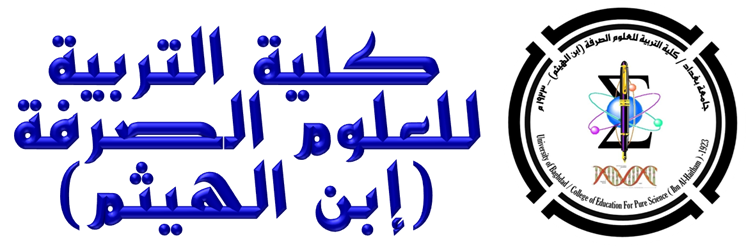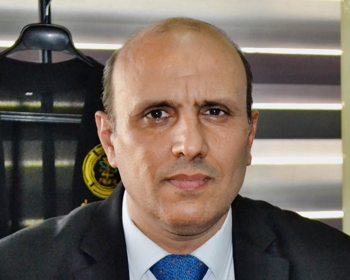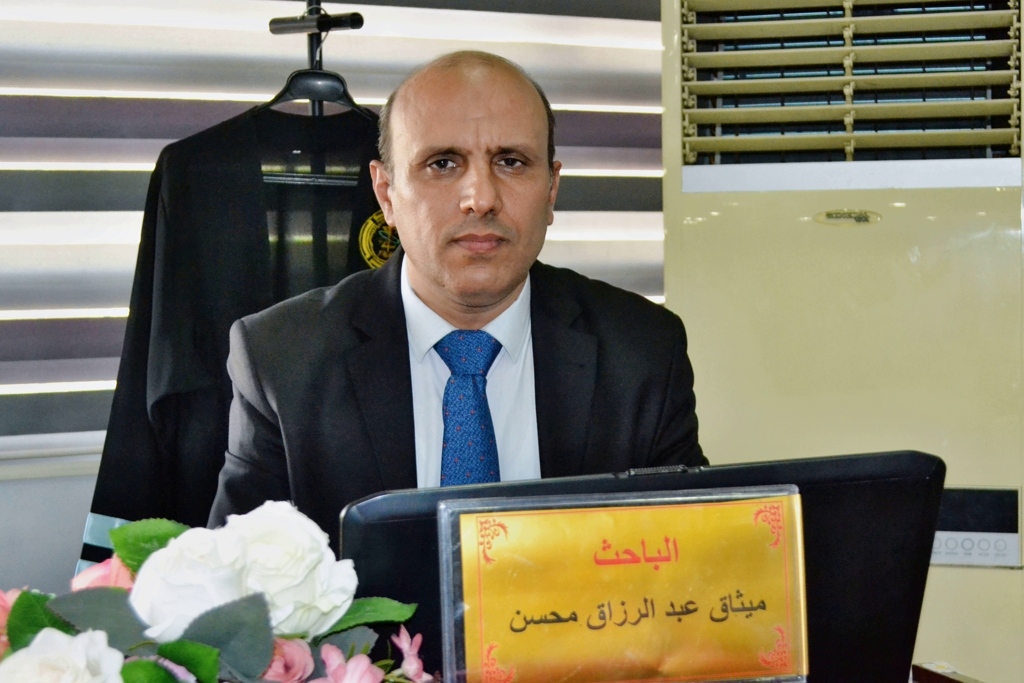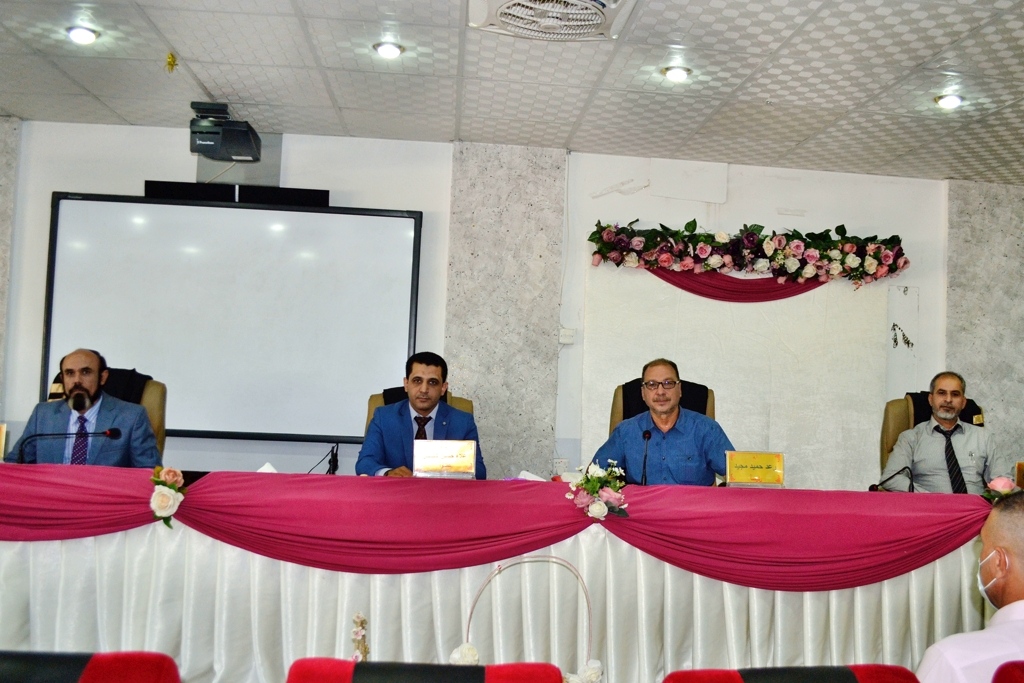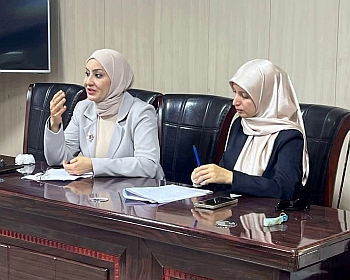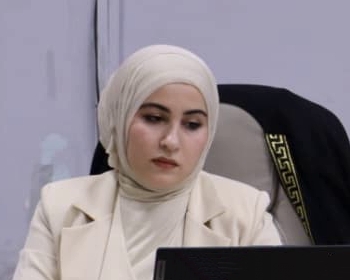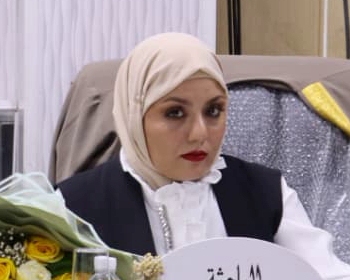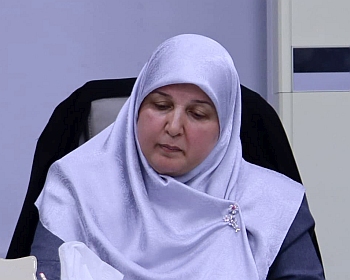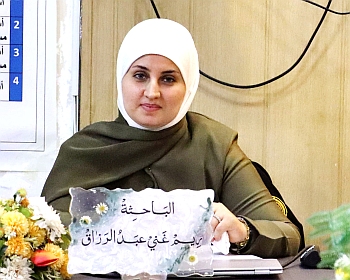ناقش قسم الفيزياء في كلية التربية للعلوم الصرفة (ابن الهيثم) رسالة الماجستير الموسومة (الحسابات النظرية للتيار الالكتروني في النباءط الالكترونية N3-ZnO و N3- TiO2باستعمال الاعتبارات الكمية) للطالب (ميثاق عبد الرزاق محسن) التي انجزها تحت اشراف التدريسي في القسم (أ.د. هادي جبار مجيبل) ونوقشت من قبل أعضاء لجنة المناقشة المبينة أسمائهم فيما يأتي :
-
أ.د. رعد حميد مجيد (رئيسا)
-
أ.م.د. احمد موسى اشويخ (عضوا)
-
أ.م.د. علاء حسين شنيشل (عضوا)
-
أ.د. هادي جبار مجيبل (عضوا ومشرفا)
ويهدف البحث الى طرح نظرية لحساب التيار الكهربائي في الخلايا الشمسية والتي تمكن الباحثين من اختيار المواد المناسبة لعمل خلية شمسية نتحكم بكفائتها.
وتم في هذه الدراسة، أُستخدم أنموذج نظري بسيط لنظرية ماركوس لدراسة معدل فيض الشحنة عبر نظام شُبه موصل – سائل , حيث طُبقت نظرية الميكانيك الكمي لتحقيق وحساب معدل فيض الشحنة في نظام مانح- مستقبل . حيث بحثنا في آلية الانتقال لفيض الشحنة لواجهات نظام شبه موصل-سائل استناداً الى أنموذج مانح – مستقبل وبفرض استمرارية مستويات الطاقة لكُلاً من شُبه الموصل وجزيئات الصبغة.
تم حساب معدل انتقال فيض الشحنة لأنظمة InAs/D149,ZnO/D149, 49MgO/D1 ,InAs/N749 , ZnO/N74 و MgO/N749من خلال طاقة إعادة التنظيم وحد الازدواج وحاجز الجهد لمستويات الطاقة عند سطح النظام(eV). بالإضافة الى دراسة طاقة إعادة التنظيم والتي تساعد الأنظمة الستة على إعادة ترتيب مستويات الطاقة لبدأ الانتقال من الصبغة إلى حزمة التوصيل لشبه الموصل في جميع الأنظمة الستة, ووجدنا أن طاقة إعادة التنظيم تزداد كدالة لنقصان معامل الانكسار للمذيبات وزيادة ثابت العزل الكهربائي في جميع الأنظمة الستة.
حاجز الجهد تم حسابه اعتماداً على الفرق بين طاقة الامتصاص للصبغة الحساسة وطاقة إعادة التنظيم وفقاً لأنموذج الاستمرارية في وسط مستقطب.
لحساب الجهد في جميع واجهات السطوح قمنا باستخدام نتائج نظرية لطاقة إعادة الترتيب توضح عملية الانتقال عبر سطح نظام شبه موصل- صبغة في وسط مستقطب. كذلك فإننا نلاحظ زيادة حاجز الجهد مع الطاقة الممتصة وطاقة إعادة التنظيم. وان معدل فيض الشحنة يصل الى أقصى قيمة له عند استخدام البروبان كمذيب, لكنهُ يتناقص تدريجياً عند استخدام المذيبات البيوتانول، الأوكتانول، يملك أعلىMgO/D149الديكلوروإيثان والأسيتونيتريل. اضافة الى ان نظام لنفس معامل InAs/D149 وZnO/D149 معدل انتقال مقارنة مع أنظمة الازدواج, والحسابات بينت أن معدل فيض الشحنة يتناقص مع زيادة حاجز الجهد ويزداد مع تناقص طاقة إعادة الترتيب .
في ضوء النتائج المقدمة للحسابات والمناقشات الحالية ، توصل الطالب الى إمكانية تبني المشاريع المستقبلية مثل:
-
دراسة تأثير درجة الحرارة على تيار اتصال الجزيء بأشباه الموصلات.
-
دراسة التأثير المحتمل على خصائص تماس الجزيئات مع أجهزة أشباه الموصلات.
-
الحساب النظري لطاقة التنشيط لتلامس الجزيء مع أجهزة أشباه الموصلات.
Theoretical Calculation of the Electronic Current at N3-ZnO and N3- TiO2 Electronic Devices Using Quantum Consideration
By Methaq Abdul Razzaq Mohsin Ali
Supervised by Prof. Dr. Hadi Jabbar Mujbil Al Agealy
Aims of the Present Work
The main aim of this thesis is to calculate the electronic current at dye sensitized solar cell depending on theoretical quantum model and the quantum transition theory approach using donor acceptor scenario . The electronic current calculates under quantum model as function of transition energy, driving force energy, barrier height coupling overlapping parameters .The electronic current is investigated theoretically for N3 contact with TiO2 and Zn O semiconductor for electrons in functional solar cells. Transition energy calculates with t electronic current in solar cell using wide polarity solvents .This study focuses in the selection of a suitable model for N3 coupled with semiconductor with solvent in Dye Sensitized Solar Cells. The effects of the transition parameters are discussion due to current model and quantum consideration
Abstract
In this thesis ,we introduce a theoretical model of the current through sensitizer N3 molecule dye contact to TiO2 and/or ZnO semiconductors using donor-acceptor scenario for electrons in functional solar cells.The current is very good tool to known the efficiency of solar cell . Theoretical model underlying depends on the fundamental parameters of the transfer reaction and it is based on the quantum transition theory approach .A quantum treatment uses to calculate the current due to transition energy ,electronic drive ,activation energy ,potential and coupling overlap strength at N3 / TiO2and N3 /ZnO devices with wide polarity solvents .Acetic acid, 2-Methoxyethanol, 1-Butanol, Methyl alcohol, chloroform, N,N-Dimethylacetamide and Ethyl alcohol solvents are taken to calculate and discussion the current theoretically of N3 / TiO2 and N3 /Zn O devices system by means of transition theory .Transition energy is a necessary parameter to calculate the current and transition parameters in N3 / TiO2 and N3 /Zn O devices solar systems. However, the transition energy is varied by varied the polarity of solvents due to dielectric constant and refractive index .Moreover, the transition energy of N3/TiO2 and N3/ZnO devices have been slightly increase with increase dielectric constant and decrease refractive index .Additionally , the current decreased with increased driving force as results to decrease chemical potential of N3 dye . The both N3/TiO2 and N3/ZnO device are shown higher current with different solvents when the driving energy varied eV. The results data of current in both systems show that current increases with decrease potential and driving energy .It was show the current is large for low driving energy and low potential .The current increased with increased transition energy in both systems and the current decreases with increase potential .The potential at interface is limited the transfer of electrons .The calculated of electronic current is shown strong dependence on transition energy and potential .It is increase with decrease transition energy and potential and vice versa .The data show that electronic current has large values() for N3/ZnO device with solvents comparing with lowest current () with solvents at driving energy consequently, the TiO2 contact with N3 is given more accept current results in room temperature with solvent comparing with N3/ZnO devices with same condition .
Suggestions for Future Work
On the present results of the current calculation and discussions, we list the current ideas to adopt future projects such as
Study the effect of temperature on the current of molecule contact to semiconductor
Study the potential effect on the characteristic of molecule contact to semiconductor devices
-Theoretical calculation of activation energy for molecule contact to semiconductor devices
